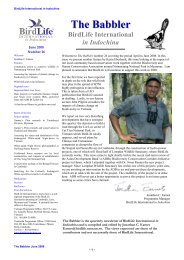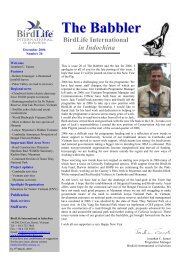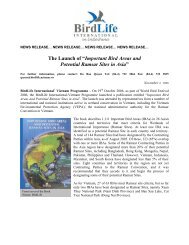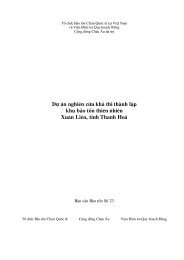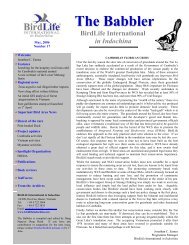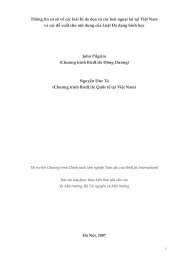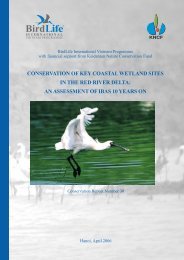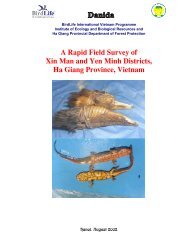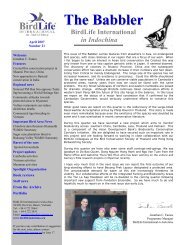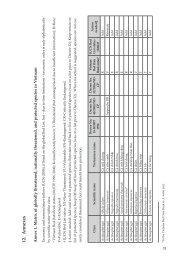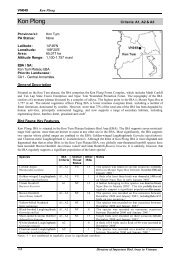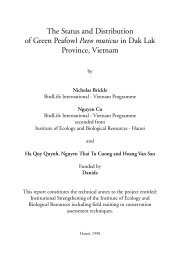The Biodiversity of Bac Huong Hoa Nature Reserve - Birdlife ...
The Biodiversity of Bac Huong Hoa Nature Reserve - Birdlife ...
The Biodiversity of Bac Huong Hoa Nature Reserve - Birdlife ...
Create successful ePaper yourself
Turn your PDF publications into a flip-book with our unique Google optimized e-Paper software.
as an Important Bird Area (IBA). This survey used interviews and opportunistic fieldwork to<br />
investigate the occurrence <strong>of</strong> IBA trigger species.<br />
Recognising the importance <strong>of</strong> the forests <strong>of</strong> BHH, a second week long survey was conducted in<br />
February 2004, focussing on the most intact areas <strong>of</strong> forest, those close to Khe Cuoi and Ban Cup<br />
villages (Le Manh Hung et al. 2004 and Dan Ngoc Can 2004). <strong>The</strong> aim <strong>of</strong> this survey was to<br />
create a more complete inventory <strong>of</strong> the bird and mammal species <strong>of</strong> the forests <strong>of</strong> <strong>Bac</strong> <strong>Huong</strong><br />
<strong>Hoa</strong> and to collect status and distribution data on globally and nationally threatened species.<br />
In April and May 2004, experts from IEBR conducted herpetological surveys in the forests <strong>of</strong><br />
<strong>Bac</strong> <strong>Huong</strong> <strong>Hoa</strong>, again focussing survey effort on the well forested areas close to Khe Cuoi and<br />
Ban Cup villages. <strong>The</strong>se surveys recorded 61 species <strong>of</strong> reptile and amphibian, including one frog<br />
species Philautus truongsonensis, which they described as new to science (Orlov and Ho Thu<br />
Cuc 2005). This remains the most comprehensive herpetological survey <strong>of</strong> the forests <strong>of</strong> <strong>Bac</strong><br />
<strong>Huong</strong> <strong>Hoa</strong> but the results were not widely published.<br />
Le Trong Trai conducted biodiversity surveys in <strong>Bac</strong> <strong>Huong</strong> <strong>Hoa</strong> in mid 2005 in preparation for<br />
the creation <strong>of</strong> an investment plan for BHH NR. <strong>The</strong> results <strong>of</strong> this survey were published in the<br />
investment plan for the nature reserve (Anon 2005). During this survey, a number <strong>of</strong> additional<br />
species were recorded for the first time and includes the only comprehensive plant survey <strong>of</strong> the<br />
area. Although this survey focused on only one relatively small area close to Cup village, 920<br />
plant species were recorded. As part <strong>of</strong> the 2005 surveys, Jeremy Holden conducted one month <strong>of</strong><br />
camera trapping with nine cameras in the forests <strong>of</strong> <strong>Bac</strong> <strong>Huong</strong> <strong>Hoa</strong> (Holden 2005). However, no<br />
mammals or birds were recorded (Le Trong Trai pers. com.), although this may in part have been<br />
because ideal locations for cameras were all already taken by snare traps set by hunters.<br />
In 2006 a rapid survey <strong>of</strong> reptiles and amphibians in Quang Tri Province was conducted, which<br />
included a short survey in the forests <strong>of</strong> <strong>Bac</strong> <strong>Huong</strong> <strong>Hoa</strong> (Cao Tien Trung in prep.). A wildlife<br />
trade survey was conducted in 2006 in 10 villages and three towns in or close to BHH NR (Dang<br />
Ngoc Can et al. 2006). This survey recorded a small number <strong>of</strong> mammal species not previously<br />
reported from the nature reserve.<br />
Since the establishment <strong>of</strong> the nature reserve, monitoring <strong>of</strong> key mammal and bird species has<br />
been conducted by Site Support Groups (SSGs) set up by BirdLife. Monitoring by these groups<br />
has yielded data on most <strong>of</strong> the key species through a series <strong>of</strong> short surveys in 2004 and 2005.<br />
However, the quality <strong>of</strong> the data is variable and difficult to quantify (Wilkinson and Nguyen<br />
Thanh Van 2006); apparent trends in populations are equally likely to relate to trends in observer<br />
skills or behavior.<br />
BHH NR has been visited briefly by other ornithologists on a number <strong>of</strong> occasions, for instance,<br />
Andrew Tord<strong>of</strong>f visited in January 2005, Nicolas Wilkinson in 2006 and Jonathan C. Eames and<br />
Simon Mahood in May 2008. Unpublished incidental observations made during their visits have<br />
been incorporated into this report.<br />
No data on fish, small mammals, bats or invertebrates have ever been recorded in BHH NR.<br />
14




